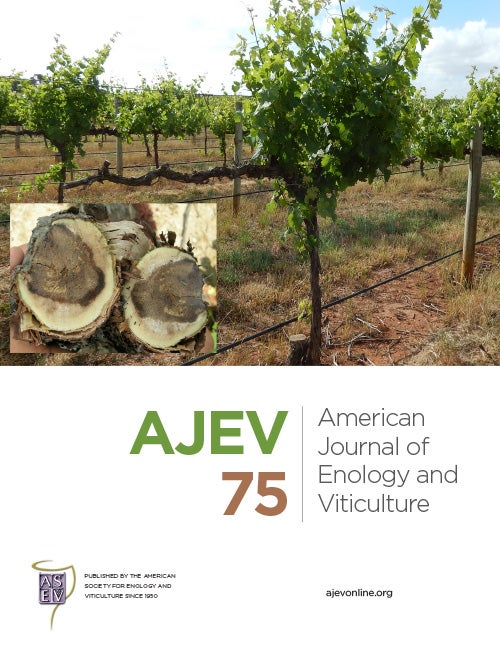2025 ASEV Best Papers Awards Announced, Available for Free
- April 14, 2025
- Category: eNews

Congratulations to the 2025 ASEV Best Papers Award winners! The selected papers will be presented at the ASEV National Conference in June in Monterey, California. You can read both papers for free on the AJEV website.
This year’s winning papers include:
For viticulture: “Trunk Cambium Facilitates Pre-Symptomatic and Year-Round Detection of Grapevine Red Blotch Virus Using the LAMP Assay,” written by Jennifer K. Rohrs, Hannah G. Fendell-Hummel, Sarah L. MacDonald, Malcolm B. Hobbs and Monica L. Cooper from the University of California Cooperative Extension, Napa County. This study found that testing grapevines for red blotch virus using a sample taken from the grapevine’s trunk (the cambium layer that separates the bark from the wood, specifically) is more effective than using leaf samples. The new method, which uses the loop-mediated isothermal amplification (LAMP) assay, can detect the virus before the appearance of symptoms. Unlike traditional leaf petiole testing, which only works during certain parts of the growing season, trunk cambium sampling can be used all year. In Napa Valley vineyards, trunk cambium sampling detected infections at a rate twice that of cane tissue sampling, and over 12 times that of petiole tissue sampling. Many vineyard managers have already begun using this technique, along with visual inspections, to detect the virus early and prevent its spread.
For enology: “Prevalence of Wildfire Smoke Exposure Markers in Oaked Commercial Wine,” by Mango Parker, WenWen Jiang, Adrian D. Coulter, Tracey E. Siebert, Eleanor Bilogrevic, I. Leigh Francis, and Markus J. Herderich from Australian Wine Research Institute. This study examined how to determine if a wine’s smoky flavor originates from standard aging in oak barrels or from exposure to wildfire smoke. Several types of Australian wines that had not been exposed to wildfire smoke were tested to establish baseline levels of smoke-related chemicals. The authors found that oak barrels naturally introduce certain smoky compounds, like guaiacol and syringol, at relatively high levels, and while markers that typically indicate wildfire exposure were present, they only occurred in small amounts. This research presents a clearer picture of the phenolic compounds typically found in oak-aged wines, enabling researchers to confidently identify which of these wines have been affected by smoke.
Share:
Latest News
ENEWS
Registration and Housing is Now Open for the ASEV National Conference
Registration and housing for the 2025 ASEV National Conference is now open! Join us for a week of science-driven presentations, networking and discovery of new...
ENEWS
2025 ASEV National Conference Preview
Highlights of the 76th ASEV National Conference: Merit Award Presentation by Mr. Larry Bettiga of University of California Cooperative Extension, Monterey County, "In the Question...
ENEWS
2025 ASEV Best Papers Awards Announced, Available for Free
Congratulations to the 2025 ASEV Best Papers Award winners! The selected papers will be presented at the ASEV National Conference in June in Monterey, California....
ENEWS
Blending Tradition and Innovations: Elizabeth Tomasino’s Journey with ASEV and Wine Science
Elizabeth Tomasino, a professor of enology at Oregon State University, has made significant strides in the field of wine science. Her work focuses on the...
ENEWS
Follow ASEV Foundation
Want to learn more about the ASEV Foundation? Like, follow and don’t forget to share with your friends on LinkedIn, Facebook, Instagram and X. Foundation’s...
